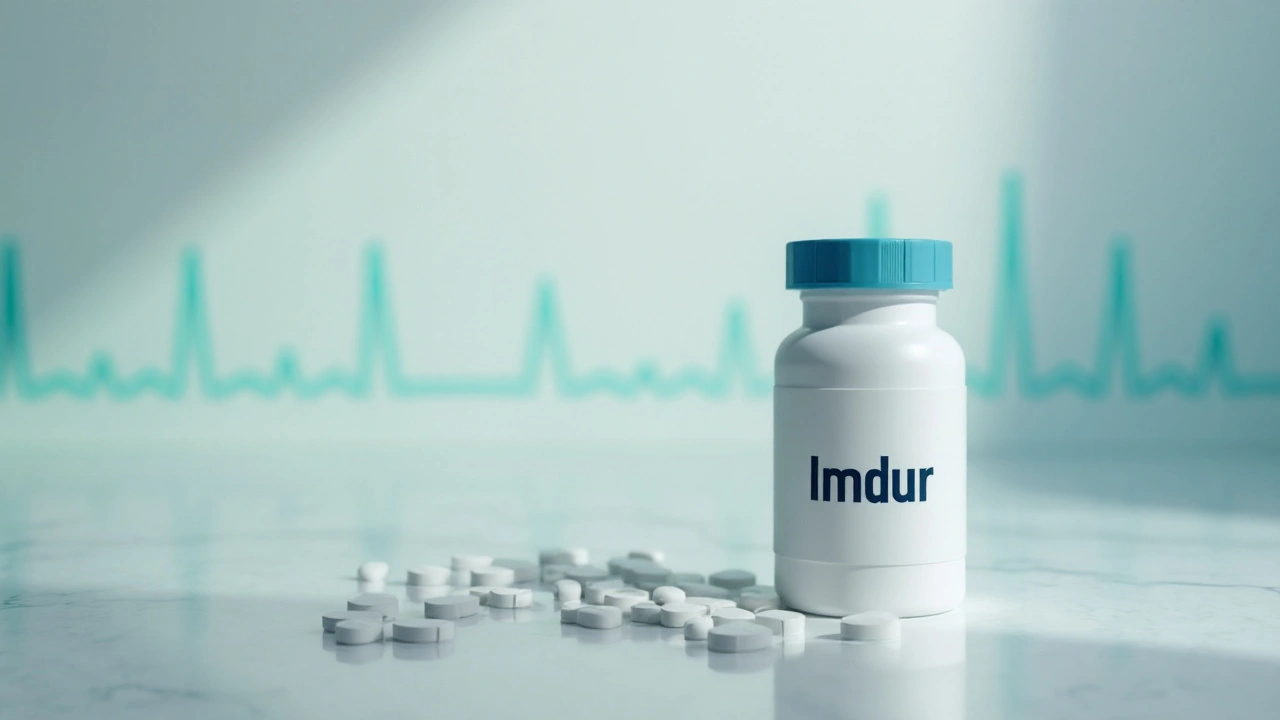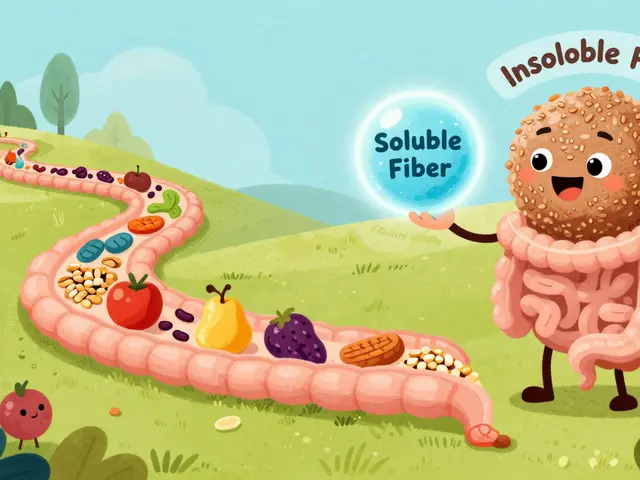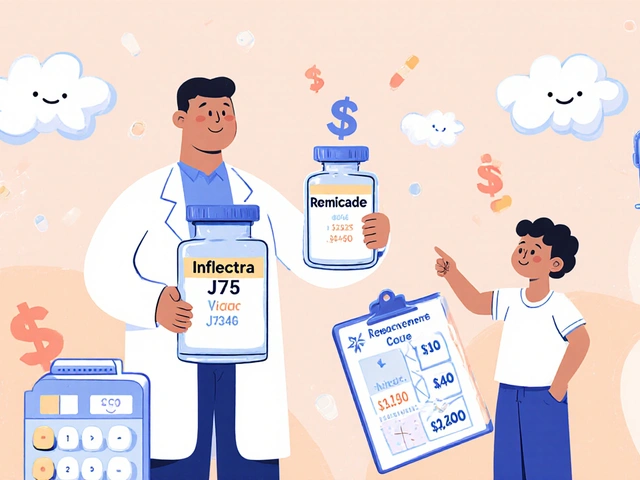TL;DR
- Imdur is the brand name for isosorbide mononitrate, a nitrate used to prevent chest pain (angina) in people with heart disease.
- Typical adult dose starts at 30mg once daily; many doctors increase to 60mg after a week, with a maximum of 120mg per day.
- Take Imdur at the same time each day, preferably in the morning, with or without food. Do not crush or chew the tablet.
- Common side effects: headache, dizziness, flushing, low blood pressure. Serious concerns include fainting, rapid heartbeat, or severe allergic reactions.
- Tell your doctor about all other medicines, especially other nitrates, erectile‑dysfunction drugs, and blood pressure meds, because interactions can be dangerous.
What is Imdur and How It Works
Imdur is a long‑acting nitrate that belongs to a class of drugs called vasodilators. Its active ingredient, isosorbide mononitrate, relaxes the smooth muscle in blood‑vessel walls. When the vessels widen, blood can flow more easily to the heart, reducing the frequency and severity of angina attacks.
The medication doesn’t cure coronary artery disease, but it helps manage symptoms so you can stay active without the constant fear of chest pain. Because it works throughout the day, Imdur is usually taken once daily, unlike short‑acting nitrates that need multiple doses.
Why does the body need a nitrate? In simple terms, the heart’s oxygen demand spikes during exercise or stress. The narrowed arteries can’t meet that demand, and you feel pain. Imdur increases the supply side-more blood reaches the heart muscle, keeping the oxygen gap small.
Most patients start feeling a reduction in angina episodes within a week, though full benefit might take up to two weeks. If you don’t notice any change after that, talk to your clinician; dosage adjustments or a different drug might be necessary.
Taking Imdur: Dosage, Administration, and Safety Tips
Getting the dosing right is the cornerstone of getting relief without unnecessary side effects. Below is the typical dosing schedule for adults with stable angina. Children and teens rarely receive Imdur, so the table focuses on adult regimens.
| Starting Dose | Typical Titration | Maximum Daily Dose | Frequency |
|---|---|---|---|
| 30mg | Increase to 60mg after 7‑10 days if well‑tolerated | 120mg | Once daily, same time each day |
| 60mg | Can be raised to 90mg after another week, then to 120mg | 120mg | Once daily, same time each day |
Key administration pointers:
- Take with water and swallow whole. Crushing the tablet can cause a rapid release of nitrate, leading to a sudden drop in blood pressure.
- Morning dosing is preferred because it aligns with the body’s natural cortisol surge, which can counteract any mild blood‑pressure dip.
- If you miss a dose, take it as soon as you remember-provided it’s at least 6hours before the next scheduled dose. Otherwise, skip it and resume your regular schedule.
- Do not double‑dose to make up for a missed tablet; the risk of severe hypotension outweighs any potential benefit.
Special situations:
- Pregnancy & breastfeeding: Animal studies show no major teratogenic effects, but human data are limited. Discuss risks with your obstetrician before starting.
- Elderly patients: Kidney function often declines with age, which can raise drug levels. Doctors may start at 30mg and monitor blood pressure closely.
- Alcohol: Moderate drinking usually doesn’t interfere, but binge drinking can amplify the blood‑pressure‑lowering effect.
Because Imdur is a nitrate, you’ll develop tolerance if you use a short‑acting nitrate (like sublingual nitroglycerin) too often. Keep a “nitrate‑free interval” of at least 8‑10hours each day to preserve the drug’s effectiveness.

Side Effects, Interactions, and When to Seek Help
Like any medication, Imdur has a safety profile you should understand. Most side effects are mild and resolve as your body adjusts.
Common (mild) side effects
- Headache - often the first sign the drug is working.
- Flushing or feeling warm.
- Dizziness, especially when standing quickly.
- Nausea or mild abdominal discomfort.
These usually subside after a few days. If headaches are relentless, a low‑dose aspirin (if not contraindicated) can help, but always check with your doctor first.
Serious (rare) side effects
- Severe hypotension (blood pressure < 90/60mmHg) leading to fainting.
- Rapid or irregular heartbeat (palpitations).
- Allergic reactions: rash, itching, swelling of face/tongue, difficulty breathing.
If any of these occur, seek medical attention immediately.
Important drug interactions
Imdur can amplify the effects of other vasodilators and blood‑pressure‑lowering agents. Here are the biggest red flags:
- Other nitrates (e.g., nitroglycerin, isosorbide dinitrate) - combined use can cause dangerous drops in blood pressure.
- PDE‑5 inhibitors (Viagra, Cialis, Levitra) - especially risky for men taking nitrates.
- Antihypertensives (ACE inhibitors, beta‑blockers, calcium‑channel blockers) - dose adjustments may be needed.
- Alcohol & recreational drugs that dilate vessels - increase the chance of dizziness or fainting.
Always hand your pharmacist a complete medication list, including over‑the‑counter supplements like StJohn’s wort or herbal teas.
When to call your doctor
- Chest pain worsens or occurs more frequently despite taking Imdur.
- Persistent headaches beyond the first week.
- Signs of low blood pressure: light‑headedness, blurry vision, or fainting.
- Any swelling, sudden weight gain, or shortness of breath not related to exercise.
Regular follow‑up appointments (every 3‑6months) let your clinician check blood pressure, heart rate, and overall symptom control.
Quick FAQ
- Can I stop Imdur abruptly? Sudden discontinuation may cause rebound angina. Taper under doctor supervision.
- Is Imdur safe for people with diabetes? Yes, but monitor blood pressure closely; some diabetic patients experience lower readings.
- What should I do before surgery? Discontinue Imdur at least 24hours prior, unless your surgeon says otherwise.
- Can I crush Imdur for a feeding tube? No. Crushed nitrates release a large dose at once and can be life‑threatening.
- Why do I feel a headache after the first dose? Nitrates cause blood‑vessel dilation in the brain, leading to a mild headache-often a sign the drug is active.

Next Steps & Troubleshooting
If you’ve just been prescribed Imdur, start with the lowest dose, keep a daily log of any side effects, and note when you feel angina relief. Use a simple spreadsheet or a phone app to track blood‑pressure readings before and after each dose. This data helps your doctor decide whether to increase the dose or switch drugs.
For anyone experiencing persistent dizziness, try the following:
- Rise slowly from lying or sitting; give your body a minute before standing.
- Stay hydrated-aim for 1.5‑2L of water daily unless fluid‑restricted.
- Ask your clinician about reducing the dose or adding a low‑dose aspirin to blunt headaches.
Remember, Imdur is a long‑term preventative therapy. Patience and open communication with your healthcare team are key to getting the best outcome.






17 Comments
Imdur’s nitrate-free interval is non-negotiable - if you don’t give your endothelium a break, you’re just training your body to ignore the drug. The whole pharmacodynamics hinges on cGMP cycling, and constant exposure desensitizes the sGC receptor. I’ve seen patients on 120mg daily with zero effect because their doc didn’t enforce the 10-hour window. It’s not just about angina - it’s about preserving vascular responsiveness long-term.
Headache on day one? 😩 That’s your blood vessels going ‘YOOOOUUU’ 🤯 I felt like my brain was trying to escape my skull. But hey - it’s working! Now I take it with coffee and it’s fine. 🫖
I’m so glad someone mentioned not crushing the tablet. My uncle did that once because he thought it’d work faster. Ended up in the ER with BP so low they had to use vasopressors. Please, just swallow it whole. 🙏
Ugh, I can’t believe people still take this. I mean, it’s literally just a glorified vasodilator from the 70s. If you’re on Imdur, you’re probably just delaying the inevitable - stents, bypass, or worse. Modern meds like ranolazine or ivabradine are way smarter. But hey, if you like feeling like you’re about to pass out every morning, be my guest. 😘
YOU GOT THIS. 💪 First week is always the worst - headaches, dizziness, feeling like a zombie. But stick with it. I was on 30mg for 3 weeks, then bumped to 60mg. Now I walk 5 miles without stopping. This drug doesn’t cure, but it gives you your life back. Don’t quit before the magic happens.
Wait so if I take this and then have a beer, I could pass out? That’s wild. I mean, I’ve had 3 beers and taken my pill and never passed out… so maybe it’s fine? 🤔
So… if I take it at 8am, can I take nitroglycerin at 9pm if I get chest pain? Or is that too risky even with the gap? I’m just trying to understand the window. Not asking for medical advice, just… curious. 😅
I’ve been on Imdur for 4 years. Headaches? Yeah, first week. Fainting? Nope. My BP is actually better now than before. It’s not sexy, but it’s reliable. I take mine with breakfast, always. No exceptions. It’s my little heart ritual.
Who even needs this drug? I mean, if your heart can’t handle a little walk, maybe you should just stop walking? Or eat less bread? I’ve never needed meds for my heart and I’m 68. Just saying.
I love how the post mentions alcohol but doesn’t say much about grapefruit. I’ve read studies where grapefruit juice increases bioavailability of nitrates by up to 40%. My grandma takes Imdur and drinks grapefruit juice every morning. I told her to stop. She said ‘but it’s so tasty!’ 🍊
It is imperative that patients be made aware that the extended-release formulation of isosorbide mononitrate must not be manipulated in any fashion, as this compromises the pharmacokinetic integrity of the delivery system and may precipitate iatrogenic hypotension. This is not a suggestion - it is a clinical imperative.
AMERICA NEEDS TO STOP GIVING OUT NITRATES LIKE CANDY. I’ve seen this stuff prescribed to people who can barely climb stairs. This isn’t a vitamin. It’s a chemical that makes your blood vessels collapse. We’re turning weak hearts into a national pastime. 🇺🇸
Just want to say - I was skeptical at first. Thought it was just another pill. But after 6 months? I played golf again. I held my granddaughter without getting winded. I didn’t know I’d lost that part of my life until I got it back. Imdur didn’t fix my arteries, but it gave me back my dignity. Thank you to the doctor who didn’t give up on me.
There’s something almost poetic about how a molecule designed to dilate vessels - originally derived from explosive compounds - became a quiet guardian of human endurance. Isosorbide mononitrate, once a wartime chemical curiosity, now lets grandmas water their roses without clutching their chest. The elegance of pharmacology… it’s not just science, it’s quiet revolution. 🌿
Let’s be real - 70% of these side effects are just placebo and anxiety. Headache? You’re stressed. Dizziness? You didn’t eat breakfast. This drug is overprescribed. People think it’s a magic bullet. It’s not. It’s a band-aid on a broken engine.
My dad’s from Mexico City. He didn’t trust this pill at first - said ‘in my village, we use garlic and hibiscus tea.’ But after three months? He’s the one who reminds me to take mine now. He says, ‘Sometimes the old ways don’t move the mountain. You need the new key.’ I think that’s beautiful.
My doctor said to take it in the morning. I took it at night. Now I wake up at 3am with a pounding headache and my heart racing. So… yeah. Don’t do that. 😅